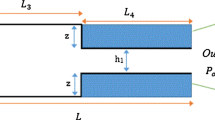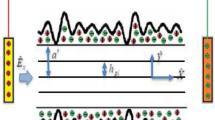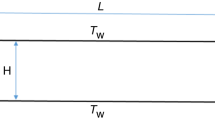Abstract
Results are presented of three-dimensional (3D) lattice Boltzmann method (LBM) simulation on pressure-driven rarefied gas flows through microchannels with a sudden contraction–expansion of 3:1:3. The main parameters examined are channel aspect ratio (AR) and Knudsen number (Kn o ) of 1–7 and 0.001–0.1, respectively. To cover the slip flow regime, a Bosanquet-type effective viscosity and a modified second-order slip boundary condition are used to account for the rarefaction effect on gas viscosity. The in-house 3D LBM code is verified by comparing the computed centerline streamwise pressure distribution and critical Reynolds number (Re c) of asymmetric bifurcation with experimental ones measured by others. The results are discussed in the way to explore effects of AR and Kn o on the bifurcation limits Re c of symmetric and asymmetric streamwise flows and effects of AR on the cross-sectional secondary flow patterns, which are lacking in the literature. Specifically, Re c for asymmetry bifurcation is found to first decrease linearly with increasing AR and then level off at 112 for AR > 3, whereas Re c decreases approximately linearly with increasing Kn o . Moreover, Re c can be correlated with AR and Kn o in a simple expression. The observed cross-sectional two- or four-pair counter-rotating vortices in the present rarefied laminar microchannel flows are new in terms of its absence in Newtonian laminar flows through straight micro- and macrochannels. Its driving force is the anisotropic secondary normal stresses over the cross-section as a result of the nonlinearity of the axial pressure gradient and, in turn, compressibility effect.














Similar content being viewed by others
References
Agrawal A, Agrawal A (2006) Three-dimensional simulation of gaseous slip flow in different aspect ratio microducts. Phys Fluids 18(10):1–11
Agrawal A, Djenidi L, Antonia RA (2005) Simulation of gas flow in microchannels with a sudden expansion or contraction. J Fluid Mech 530:135–144
Alexeenko AA, Gimelshein SF, Levin DA (2005) Reconsideration of low Reynolds number flow-through constriction microchannels using the DSMC method. J Microelectromech S 14(4):847–856
Arkilic EB, Schmidt MA, Breuer KS (1997) Gaseous slip flow in long microchannels. J Microelectromech S 6(2):167–178
Beskok A, Karniadakis GE, Trimmer W (1999) A model for flows in channels, pipes, and ducts at micro and nano scales. Microscale Thermophys Eng 3:43–77
Boger DV (1987) Viscoelastic flows through contractions. Ann Rev Fluid Mech 19:157–182
Bradshaw P, Wong FYF (1972) The reattachment and relaxation of a turbulent shear layer. J Fluid Mech 52:113–135
Chen S, Chen H, Martinez DO, Matthaeus WH (1991) Lattice Boltzmann model for simulation of magnetohydrodynamics. Phys Rev Lett 67:3776
Cherdron W, Durst F, Whitelaw JH (1978) Asymmetric flows and instabilities in symmetric ducts with sudden expansions. J Fluid Mech 84(1):13–31
Chiang TP, Sau A, Hwang RR (2011) Asymmetry and bifurcations in three-dimensional sudden-contraction channel flows. Phys Rev E 83:046313
Drikakis D (1997) Bifurcation phenomena in incompressible sudden expansion flows. Phys Fluids 9(1):76–87
Durst F, Melling A, Whitelaw JH (1974) Low Reynolds number flow over a plane symmetric sudden expansion. J Fluid Mech 64(1):111–128
Durst F, Pereira JCF, Tropea C (1993) The plane symmetric sudden-expansion flow at low Reynolds number. J Fluid Mech 248:567–581
Fearn RM, Mullin T, Cliffe KA (1990) Nonlinear flow phenomena in a symmetric sudden expansion. J Fluid Mech 221:595–608
Gad-el-Hak M (1999) The fluid mechanics of microdevices. J Fluids Eng 121:5–33
Gao SX, Hartnett JP (1996) Heat transfer behavior of Reiner–Rivlin fluids in rectangular ducts. Int J Heat Mass Transf 39:1317–1324
Guo ZL, Shi BC, Zhao TS, Zheng CG (2007) Discrete effects on boundary conditions for the lattice Boltzmann equation in simulating microscale gas flows. Phys Rev E 76:056704
Guo ZL, Zheng CG, Shi BC (2008) Lattice Boltzmann equation with multiple effective relaxation times for gaseous microscale flow. Phys Rev E 77:036707
He B, Chen Y, Feng W, Li Q, Song A, Wang Y, Zhang M, Zhang W (2012) Compressible lattice Boltzmann method and applications. Int J Numer Anal Mod 9(2):410–418
Homayoon A, Meghdadi Isfahani AH, Shirani E, Ashrafizadeh M (2011) A novel modified lattice Boltzmann method for simulation of gas flows in wide range of Knudsen number. Int Commun Heat Mass 38:827–832
Huang CY, Lai CM (2012a) Experimental investigation of flow fields inside microchannel devices. Master’s thesis. National Tsing Hua University
Huang CY, Lai CM (2012b) Pressure measurements with molecule-based pressure sensors in straight and constricted PDMS microchannels. J Micromech Microeng 22:065021
Karniadakis G, Beskok A, Aluru N (2005) Microflows and nanoflows fundamentals and simulation. Springer, USA
Kim SH, Pitsch HP, Boyd ID (2008) Accuracy of higher-order lattice Boltzmann methods for microscale flows with finite Knudsen numbers. J Comput Phys 227:8655–8671
Lee T, Lin CL (2005) Rarefaction and compressibility effects of the lattice Boltzmann equation method in a gas microchannel. Phys Rev E 71:046706
Li X, Lee WY, Wong M, Zohar Y (2000) Gas flow in constriction microdevices. Sens Actuators A 83:277–283
Liou TM, Lin CT (2014) Study on microchannel flows with a sudden contraction–expansion at a wide range of Knudsen number using lattice Boltzmann method. Microfluid Nanofluid 16:315–327
Michalis VK, Kalarakis AN, Skouras ED, Burganos VN (2010) Rarefaction effects on gas viscosity in the Knudsen transition regime. Microfluid Nanofluid 9(4–5):847–853
Nie X, Doolen D, Chen S (2002) Lattice Boltzmann simulations of fluid flows in MEMS. J Stat Phys 107:279–289
Oldroyd JG (1965) Some steady flows of the general elastico-viscous liquid. Proc R Soc Lond Ser A 283:115–133
Oliveira MSN, Rodd LE, McKinley GH, Alves MA (2008) Simulations of extensional flow in microrheometric devices. Microfluid Nanofluid 5:809–826
Pappaert K, Biesemans J, Clicq D, Vankrunkelsven S, Desmet G (2005) Measurements of diffusion coefficients in 1-D micro- and nanochannels using shear-driven flows. Lab Chip 5:1104
Park HM, Lee WM (2008) Effect of viscoelasticity on the flow pattern and the volumetric flow rate in electroosmotic flows through a microchannel. Lab Chip 8:1163–1170
Qian Y, d’Humie`res D, Lallemand P (1992) Recovery of the Navier–Stokes equations using a lattice-gas Boltzmann method. Europhys Lett 17:479
Ramesh K, Agarwal Lee Chusak (2011) Lattice Boltzmann simulations of slip flow of non-Newtonian fluids in microchannels. Lect Notes Comput Sci Eng 74:247–256
Sbragaglia M, Succi S (2005) Analytical calculation of slip flow in lattice Boltzmann models with kinetic boundary conditions. Phys Fluids 17:093602
Scott PS, Mirza FA (1986) A finite element analysis of laminar flows through planar and axisymmetric abrupt expansions. Comput Fluids 14(4):423–432
Sobey IJ (1985) Observation of waves during oscillatory channel flow. J Fluid Mech 151:395–426
Sobey IJ, Drazin PG (1986) Bifurcations of two-dimensional channel flows. J Fluid Mech 171:263–287
Succi S (2002) Mesoscopic modeling of slip motion at fluid-solid interfaces with heterogeneous catalysis. Phys Rev Lett 89:064502
Syrjala S (1998) Laminar flow of viscoelastic fluids in rectangular ducts with heat transfer: A finite element analysis. Int Commun Heat Mass Transf 25(2):191–204
Tang GH, Tao WQ, He YL (2004) Lattice Boltzmann method for simulating gas flow in microchannels. Int J Mod Phys C 15(2):335–347
Tang GH, Zhang YH, Gu XJ, Emerson DR (2008) Lattice Boltzmann modeling Knudsen layer effect in non-equilibrium flows. EPL 83:40008
Verhaeghe F, Luo LS, Blanpain B (2009) Lattice Boltzmann modeling of microchannel flow in slip flow regime. J Comput Phys 228:147–157
Whitesides GM (2006) The origins and the future of microfluidics. Nature 442:368–373
Wille R, Fernholz H (1965) Report on the first European mechanics colloquium, on the Coanda effect. J Fluid Mech 23(4):801–819
Xue SC, Phan-Thien N, Tanner RI (1995) Numerical study of secondary flows of viscoelastic fluid in straight pipes by an implicit finite volume method. J Non-Newton Fluid Mech 59:191–213
Zhang YH, Gu XJ, Barber RW, Emerson DR (2006) Capturing Knudsen layer phenomena using a lattice Boltzmann model. Phys Rev E 74:046704
Zou Q, He X (1997) On pressure and velocity boundary conditions for the lattice Boltzmann BGK model. Phys Fluids 9:1591–1598
Acknowledgments
The study is supported by the national science council (ROC) under the Grant No. NSC 97-2221-E-007-036-MY3.
Author information
Authors and Affiliations
Corresponding author
Electronic supplementary material
Below is the link to the electronic supplementary material.
Rights and permissions
About this article
Cite this article
Liou, TM., Lin, CT. Three-dimensional rarefied gas flows in constricted microchannels with different aspect ratios: asymmetry bifurcations and secondary flows. Microfluid Nanofluid 18, 279–292 (2015). https://doi.org/10.1007/s10404-014-1431-x
Received:
Accepted:
Published:
Issue Date:
DOI: https://doi.org/10.1007/s10404-014-1431-x




